Stretching Your Ad Budget (Part 3) – Increasing Visibility
In the first two parts of this series, we discussed a couple of different strategies you might want to use your marketing dollars for, but at the end of the day the goal of any author comes down to one of two things (and often both). Selling more books, and getting more readers. In either case, increasing the visibility of your book is key – you run ads on your books so that more people see them, you increase your readership so more people know about you and talk about you, which also leads to more sales and more readers. Running ads to sell books or grow your subscriber base are great ways to do this, but there is another way you can make readers more aware of your book – by weaving its presence directly into the digital algorithms of Amazon itself.
Each of the parts of this series have been about strategies for promoting your book, and we’ve then broken down tactics towards achieving that goal. The third strategy we’ll examine is how to make your book more visible organically, in the structure of Amazon’s recommended books section. One of the most powerful methods is also the least intuitive – the concept of giving away copies of your book through KDP Select’s Free Promotion tool.
What do you mean by organic visibility?
Organic visibility is defined as placement of your book in front of potential customers that you didn’t (directly) pay for. It’s different to a Sponsored Product on Amazon, because you didn’t have to pay for your book to be featured there – Amazon’s algorithms selected and presented your book on the basis that it calculated yours was a product that would make an attractive purchase for the intended viewer.
For example, this is the Kindle Store landing page, which presents me with the best-selling fiction and non-fiction books according to Amazon’s own sales figures:
Obviously, as a reader, this places all sorts of attractive potential purchases right in front of you – right when you’re in the mood to spend money on a book! As you can imagine, this is the best advertising opportunity that money (can’t) buy – and why being placed in the top ranks of the best-seller’s list is such a highly sought after sales tactic for authors.
But it doesn’t stop there…
If you click on any of these books, these same opportunities for organic visibility present themselves – in the form of what authors and marketers call the ‘Also Bought’ section:
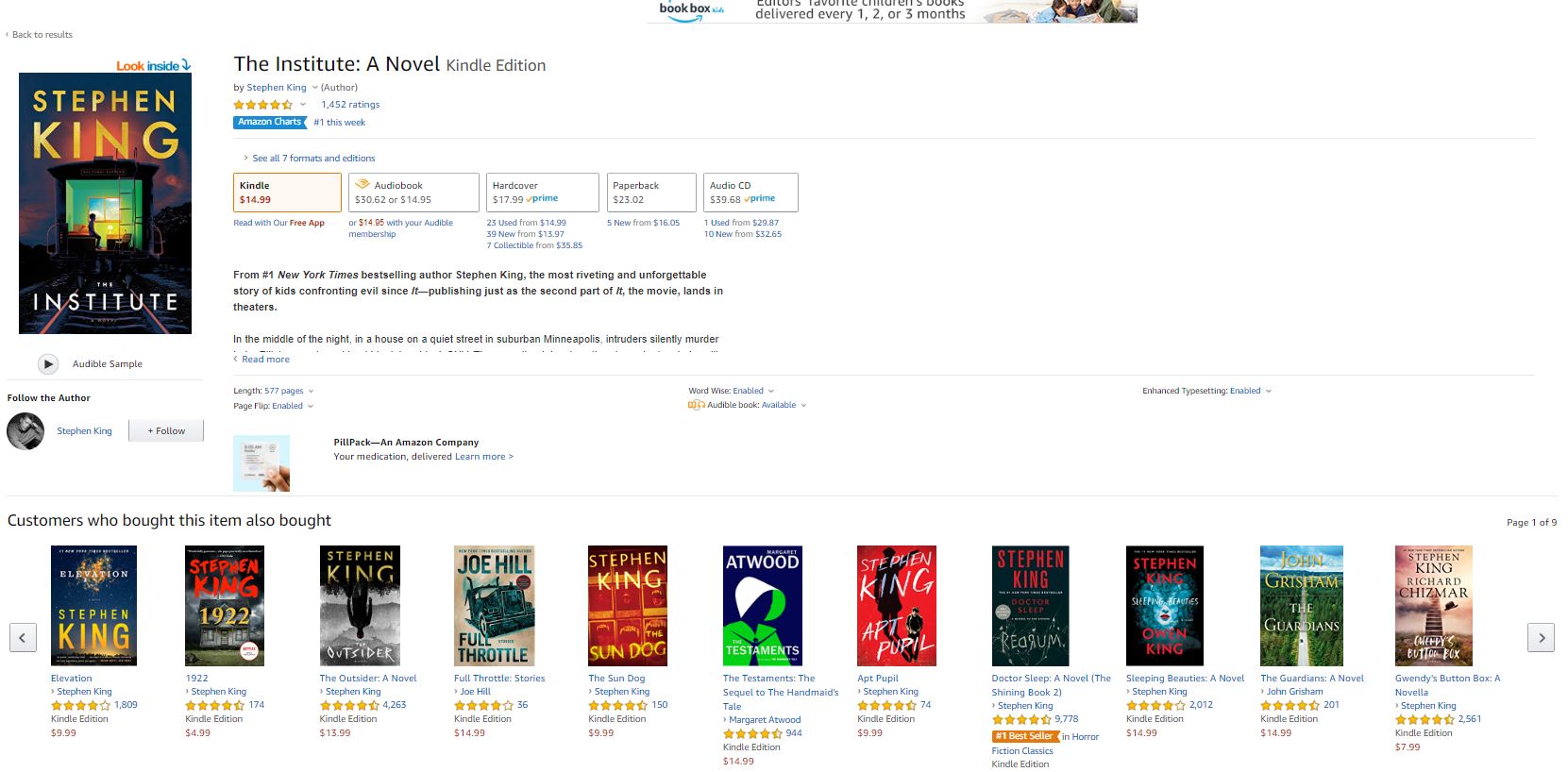
As you can see, people who view Stephen King’s latest book, The Institute will get presented with a 9-page ribbon of suggested purchases directly below the blurb, entitled “Customers who bought this item also bought.” These suggestions are presented according to Amazon’s calculations – with an algorithm that tracks the other purchases of people who’ve bought Stephen King’s book, and then lists them in order of popularity.
I mean, I’m not entirely sure it’s as simple as that (Amazon’s methods for calculating this stuff are a more closely kept secret than The Colonel’s Secret Recipe) but it’s certainly the most significant part of what qualifies a book to be featured in the also bought section.
For example, you can safely assume that the most-purchased book by customers who’d bought The Institute was Elevation – which makes sense as it was Stephen King’s previous release.
In fact, every single book on the first page of that ribbon is a Stephen King book – which isn’t really surprising, since it’s a safe bet that Stephen King’s best customers are fans of Stephen King.

Yet, by the time you get to the seventh page of that ribbon, you can see other authors being featured, like Dean Koontz and Joe Hill. This makes a lot of sense, since they right in similar genres – in fact, Dean Koontz and Stephen King were side by side in my own bookcase as a paperback-devouring teenager.
Now, given that Stephen King has written 61 novels and 6 non-fiction books, and his 45 pre-written novels were all released practically simultaneously on Amazon’s Kindle when it launched in 2007, that means it’s hardly surprising that the Also Bought section of his books are all filled with his other books.
But for those authors not at Stephen King’s level of success, even the first page of the Also Bought section of their books will prominently feature the books of other authors – for example, an author popular with Hidden Gems subscribers, Jordan Vezina, has books by James Rosone, Jack Slater and Todd McLeod featured in the Also Bought section of his latest release, The Black Tsar.
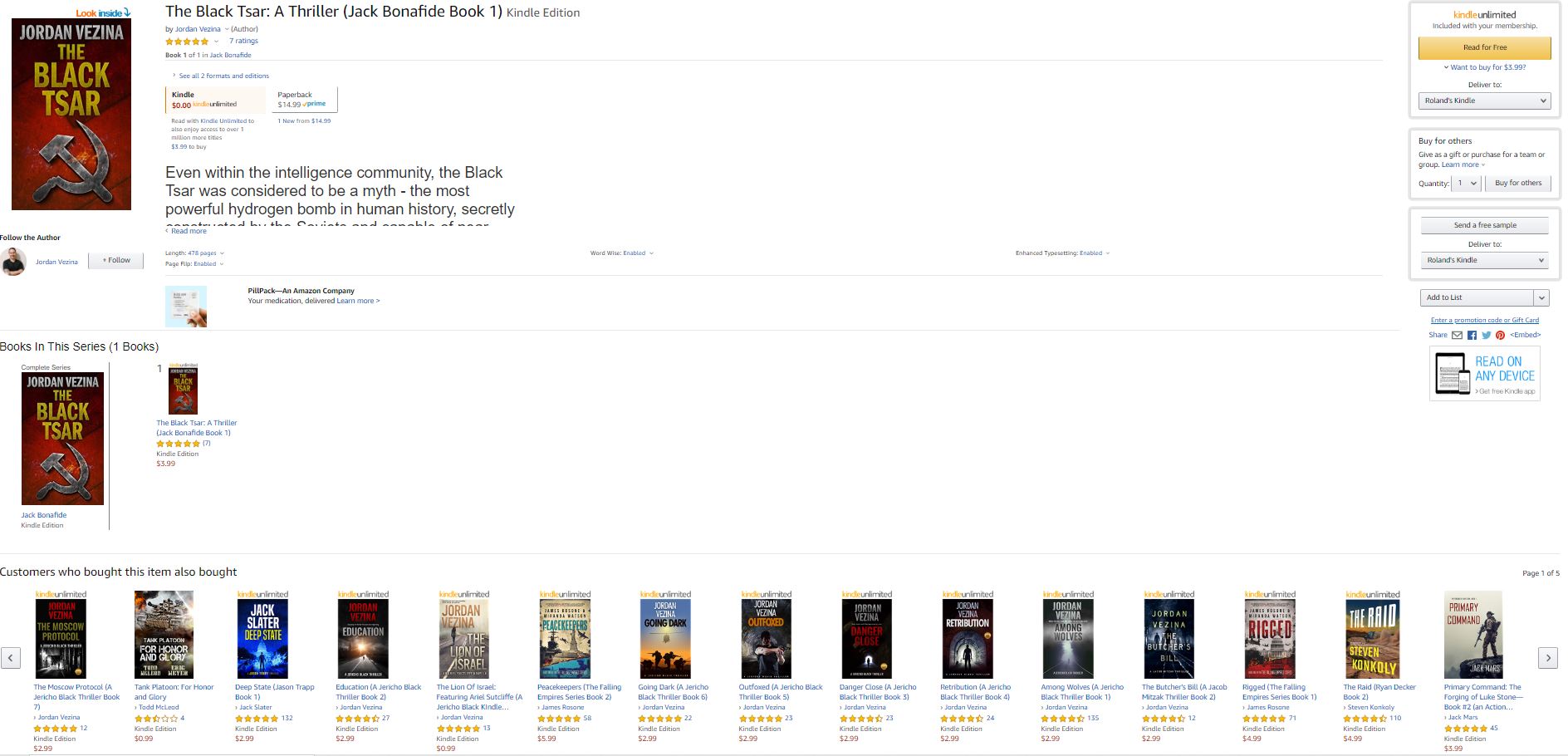
Jordan is a successful author, but he’s not live-in-a-haunted-house-in-Maine-and-feature-in-a-movie-adaptation-of-your-own-book successful (yet, but give it time.) So, that demonstrates that there’s a tactic within reach of all self-published authors to find your books featured in the Also Bought section of more successful authors.
Now, the most obvious tactic is to simply sell a lot of your own books to people who also buy the books of those other authors – which is basically everybody (can you name anybody who’s only ever bought a single author’s books?) Basically, every book you sell has the chance of being featured in the Also Bought section of any other author that your customer has also purchased a book from.
The best part of this, as opposed to simply being featured in the Best-Seller lists on the Kindle Store landing page, is that most methods of advertising mean you’ll already be trying to appeal to customers who like a particular genre of books, based on categories or popular authors from that genre. Therefore, the people who might see your book featured in the Also Bought section of another author’s books will most-likely be fans of that particular style of book and genre or category already.
I described them as ‘the best ads money (can’t) buy’ and that’s no exaggeration. In fact, if you compare the Also Bought section of a book to the Sponsored Content ribbon, you’ll see that they’re deceptively similar – and this isn’t an accident. Amazon wants them to be so closely linked from a visual perspective that it’s difficult to tell the difference between them – and the fact that you’ll be dropped down to the Sponsored Content ribbon of any book you click on by default means that Amazon wants you to get confused.

Amazon understands that customers value the Also Bought section because it is a calculated, scientific selection of books they may enjoy reading because it is based on the fact that other readers have bought both books – which means it carries much more authority than an advertisement for a random book which simply paid the most to be in that spot.
And that’s why there is so much value in having your book featured in the Also Boughts.
In fact, getting a spot there is actually better than advertising – even when you ad costs are really low. That’s because advertising is, by default, limited in length (as is, once you stop paying, you stop displaying). A book featured in the Also Bought section of another author, however, can potentially live on forever – for free.
So, the question is – how can you get your book featured in the Also Bought section of other author’s books? Well – there are two tactics.
Tactic #1 – Target popular authors in your genre for paid sales
As a tactic towards being featured in the Also Bought section of popular authors from your genre, the simplest is to have fans of those authors purchase your book. As soon as they do, it creates a link between you and this other author; and your books could potentially show up in the Also Bought section of his product pages, just like his books could now potentially show up in yours. I say potentially because there are only a limited number of books listed in the Also Bought section, so only the books that are linked the best will show up (that is, the more copies of your book that you sell to the readers of the book you’re targeting, the higher up on the list of Also Boughts you’ll be displayed).
I know what you’re thinking: “So, the tactic to selling more books is to… sell more books?” And that’s exactly right. When a reader purchases your book on Amazon, you don’t just earn your book royalties, but you also get free advertising by slithering into the Also Bought section of the customer’s other favorite authors. Obviously, this is a bit of a chicken/egg situation, so a lot of authors try to kickstart that process through paid advertising. The only difference is the strategy behind this tactic – earning royalties versus increasing visibility.
As far as the practicalities of this tactic go, there’s not much difference to what we’d discussed in Part One. It’s very likely you’re already targeting fans of a particular author through whatever methods of audience targeting you’re doing – such as featuring the names and book titles of other authors as keywords in your Amazon ads, or using fans of particular authors as a tag when you generate audiences on Facebook. It’s a more effective way to sell books; and the increased visibility happens by default – because any fans of your books will organically feed into Amazon’s algorithms for targeting the books of other authors. Like a snowball, the more successful you are as an author, the more successful you’ll become as an author.
So, good news – this is the tactic that takes care of itself. Anything you can do to sell more copies of your book will make your book more visible to other potential purchasers.
Tactic #2 – Leverage KDP Select’s Free Promotion tool.
Just like paid advertising can kickstart the process for having your books featured in the Also Bought section of other author’s books, there is a tactic you can use to give that propagation a boost – by giving your books away for free!
I know what you’re thinking – free? Are you bonkers? How am I going to earn a living as an author by giving my books away for free?
Well, there’s one very good reason: It’s a very effective technique of increasing visibility of your book.
Here’s how the tactic works: If your books are part of the KDP Select program – in which you pledge exclusivity to the Amazon Kindle platform for renewable 90-day periods – you’ll have certain benefits, one of which is the Free Book Promotion, which gives you 5 days in each of your 90-day exclusivity periods in which to give your book away for free.
Because it all happens within the Amazon ecosystem, it’s all recorded by the Amazon algorithms – and when it comes to Amazon’s algorithm for choosing the books to feature in the Also Bought section, they don’t differentiate between books that were sold for money, and those which were downloaded during a Free Book Promotion period. As in, every book you give away for free will weave the tendrils of your book into the Product Pages of other author’s books – providing you with what I’d described earlier as “the best advertising money (can’t) buy”.
This means that giving away free copies can be an incredibly powerful marketing strategy, and that shouldn’t come as any surprise – after all, that’s why it exists! Amazon wouldn’t offer you the opportunity to give your book away for free unless they felt that it would provide some benefit (since they make no money on you giving away free copies, but still bear hosting and delivery costs). The question now becomes – how many copies can you give away? And how can you give your books away for free without cannibalizing your own potential sales?
Well, I’ve got a very good answer for that – and it’s one of the most important things that you, as an author, should know about Amazon’s customers: They silo themselves.
Just as readers tend to stick to particular genres of books – purchasing mostly romance, or mostly thrillers – they also tend to silo themselves depending on the price of the book in question. I would categorize these readers types into four different tiers.
First Tier Readers like to buy the same books as they can get at brick-and-mortar bookstores. These are the readers who favor traditionally-published authors, and will be swayed by book reviews in traditional media, or follow venerable authors who pre-date the Kindle (like Stephen King, for example.) The interesting thing about these readers is that they’re happy to pay traditional publishing prices for ebooks – from $9.99 upward. In fact, these readers might consider any ‘cheap’ book to have less value because, like shampoo, there’s a perception that the more expensive it is, the better it is.
Second Tier Readers are those who will purchase a book for a reasonable price – ‘reasonable’ being determined by Amazon. These are the readers who most commonly buy self-published fiction that’s part of Kindle Unlimited – with price points around $2.99 (which is the lowest price at which Amazon will give authors 70% royalties.) Just like the previous silo have preconceptions about the price of books, so does this tier – assuming that $2.99 and $3.99 is the ‘right’ price for the type of book they’re looking for and generally won’t purchase anything above that limit, even from their favorite authors. Likewise, they might favor books that are part of the Kindle Unlimited program for the same reason. It’s worth remembering that every download you get through being part of the KDP Select program still counts as a purchase in the eyes of the Amazon’s algorithm, so will still count as Also Boughts.
Third Tier Readers are very price-focused, and tend to purchase eBooks for the minimum purchase price of 99 cents and not a penny more. Most authors, myself included, will launch a book at 99 cents to target this audience; when we’re more interested in the volume of sales (to help our Sales Rank) than the money we’ll receive from them. However, outside of Kindle Unlimited it’s not really sustainable to keep your book at 99 cents, so you won’t take these readers with you if you increase the price of your book.
Fourth Tier Readers are those who only download books that are available for free – and this is a really good deal for them, because there are more books featured for free on Amazon than any person could read in a lifetime. In fact, there are more books downloaded by these readers than they could read in a lifetime; but that’s okay. They don’t have to read your book for it to be registered in the Also Bought algorithm; they just have to download it. All your book has to do is be appealing enough for them to click that ‘Buy Now’ button – they don’t even have to make the commitment to read it.
The really exciting thing is that while the purchase behaviors of these four silos rarely change (you won’t often have a first tier Amazon customer trawling the ‘free’ lists) the types of books they read (and the authors they read) are shared among (almost) all of them.
Since Amazon doesn’t seem to differentiate between readers who purchase books at tradpub list price of $9.99 and readers who only download free titles, this means any time you make sales to any of these customers, it sneakily adds your book into the Also Bought algorithm for the other authors they buy or download books by.
What does this mean to you? Well, as a self-published author you should be aiming to put your book in front of the second tier of Amazon customers – who pay full price for self-published titles that appeal to their niche and genre.
However, you can also invest in blitzing the 99 cent and free tiers during the initial launch of your book – because it’s much easier to turn them into customers (giving a book away, or making a sale at 99 cents, is infinitely easier than a full-priced $3.99 sale or higher.)
This is why a lot of authors initially launch their book at 99 cents – to really get the sales moving, even if they might (in the short term) be losing money on any advertising they’re doing to generate these sales. And of course, the other reason why this is a good tactic is the impact it has on your sales rank, which is your position in Amazon’s internal sales charts. If your book ranks highly in its genre, category or the entire Kindle store itself, you’re putting it in front of a lot more potential customers.
Free Book Promotions and Sales Rank
We wrote about Sales Rank last week, but it’s worth reiterating some of the details here; especially when it comes to Free Book Promotions.
Books that are part of a Free Book Promotion don’t impact your paid sales rank (although if they’re downloaded as part of the Kindle Unlimited program, that does count as a paid sale) because free books have their own ranks; and the more books you give away on a Free Book Promotion, the higher your book will rank in the free charts. Just like with the paid best-seller lists, once you crack the Top 100 in your category (or even the store overall) you’ll suddenly be visible to a ton of new potential readers, and your downloads will increase massively.
In both paid sales and Free Book Promotions, there’s a ‘tipping point’ at which your book has become so visible through paid promotion that suddenly it generates downloads and sales all by itself. This is the sweet spot – the goal of every determined book promoter – and a lot of authors gamble a big budget to promote their book hoping (anticipating) that when downloads reach a certain point, they’ll hit that tipping point and all the money they invested to get there will be recouped.
There’s a lot more to it than that – but successful authors with a regular release schedule, a consistent product, and a process towards promoting their books will find that this step in promoting their book becomes less and less of a gamble and more of an investment.
You just have to remember that the goal of a Free Book Promotion isn’t to make money, but to give away as many copies of your books as possible. You’re rarely cannibalizing sales because the people who download books for free (the fourth tier of Amazon customers) will rarely purchase a book even at 99 cents; so you’d be unlikely to turn them into customers or readers in the first place.
But they do impact your visibility on Amazon because the books they download for free will translate into Also Boughts – and because Amazon doesn’t differentiate between free downloads and paid sales, it means the all-important third (or second) tier of Amazon customers will see your book on the product page of similar titles, and hopefully that will eventually translate to paid sales at full price once your free promo is over.
So, how do you get readers to download your free book?
Okay, so if I’ve sold you on the concept of using a Free Book Promotion to maximize your organic visibility on Amazon, there next question is – how?
Well, in general it’s no different to how you’d go about selling copies of your book – using the same advertising channels. The only difference is that you don’t have to worry so much about getting a return on investment for your advertising, because the strategy behind this isn’t to receive money for your books, but just increase how many Also Bought sections they’re featured in.
The other difference is that Free Book Promotions are inherently short-lived*, because you can only give away copies of your book for a maximum of 5-days during any of your 90-day KDP Select enrollment periods. This means that instead of focusing on advertising strategies that provide a positive return on investment, are sustainable and scalable – you just want to maximize your impact during your five days of Free Book Promotion.
For that reason, the following tactics below are best to ‘stack’ – as in, don’t rely on just one, but run as many as you can over the same promotional period. I normally start strong with as many as I can organize on Day One, so hopefully my book will reach the Top 100 of the Free Book Charts on Amazon, and then hit the ‘tipping point’ at which the downloads multiply faster than what my own promotions alone could lead to. It’s always about visibility.
Just accept that you may never see a direct return on this investment – so never spend money you can’t afford not to get back. In theory, you will see a return as soon as the book reverts to paid sales, but there’s barely even a dotted line between the two; and your mileage might vary depending on the genre and feel of the book.
Tactic #1 – Rely on Amazon
One thing you’ll observe is that as soon as you set your book to free, people will begin to download it. Amazon sets up their organic visibility to highlight books entering a free promotion; even if it’s to a limited crowd, and for a limited time. Even if you’re not prepared to take any of the following steps below, just be aware that having your book on a Free Book Promotion will help your visibility and sales; although the more and more competition you face, the less impact this has.
Tactic #2 – Use your Mailing List
I argued above that setting your book to free won’t cannibalize your sales. Well, the exception to this rule comes if you use your mailing list. If you’ve built up a subscriber list of any significance, they’re fans of your books – and that means they’ll take the rare step of moving from paid customer to free downloader if they become aware that your book is available for free. That being said, it also means alerting your mailing list to when your books are available for free can have a massive impact. I generally launch a book at 99 cents and promote it to my mailing list, with the caveat that it’ll be available on a free promotion in a few weeks. That way, readers willing to pay or use their Kindle Unlimited subscription to get a copy of my new release will help boost my sales; but I’m not being disingenuous by demanding people pay for my book, and then give it away for free a week later.
Tactic #3 – Advertising on Amazon
So, if you’re using Advertising on Amazon to promote your books, it doesn’t differentiate between books on a Free Book Promotion and books selling for the regular price. This means it CAN be a highly effective way to get your book in front of potential readers; but you’re paying for every click, and since you’re not seeing a return on that investment, it might not be worth it to you. Some authors argue this point, but I normally suspend my Advertising on Amazon campaigns when I’m running a free book promotion because it seems like a poor use of money.
Tactic #4 – Advertising on Facebook
When it comes to Facebook, however, I argue the opposite. Some of the most powerful and cost-effective advertising I’ve done during a Free Book Promotion is on Facebook, and I’ll hit it hard during my five promotional days. Because you’re giving your book away for free, you’ll often see a lot more traction than trying to sell full-priced copies of your books, and if you get your audience right, you’ll see as big an impact as you care to pay for. It’s expensive – but one of the most effective ways to ensure your book hits the Top 100 Free Books charts, especially in combination with other advertising or promotions.
Tactic #5 – Advertising on other Social Media
The same can be said of advertising on Twitter and other social media channels. This is almost what advertising on social media was invented for – with instant visibility and limited timeframes, totally in contradiction to the slow-and-steady drip that Advertising on Amazon can deliver. One important thing to remember, though – and this goes for Facebook, too – is not to use an Amazon Affiliate Code with the URL you direct clicks to. Amazon doesn’t just refuse to count affiliate links that come from free book downloads, but if you get enough of them, it can eliminate all affiliate earnings for that month. Amazon’s TOS state that you can’t use Affiliate codes on social media either, so tread carefully.
Tactic #6 – Advertise via a Newsletter
Just like paid newsletters such as BookBub can be incredibly effective for generating sales, they can also deliver incredible results when you’re giving away free copies of your book. Newsletters are a mainstay of my promotion efforts, and I’ll stack as many as I can to go out on the first day of my promotion.
Tactic #7 – Advertise via a Website, Blogger or with an Influencer
Finally, if you’ve built up any networks of authors who write in similar categories to you, free books can be a great opportunity to leverage that connection. A lot of other authors are happy to promote other authors during a free book giveaway – especially if they’re between releases – and influencers and bloggers are likewise happy to promote free books (if they think they’re a good match for their audience) because it helps them by offering something valuable to their fans and subscribers.
* It’s worth briefly mentioning that there is one other way to set your book for free on Amazon, which doesn’t require your book to be part of the KDP Select program. Essentially, Amazon will price match books that are found at a lower price on other bookstores, which means that if you set your book for free on Apple iBooks, for example, and then report that link to Amazon, they will eventually make your book free on Amazon as well. This method is more difficult and less reliable, and is often used more by authors that want to make their book free permanently (as opposed to for a limited time). Typically, this is done strategically for other reasons than Also Bought considerations – such as setting the first book of a series to free in order to attract more readers and get them hooked into paying for the next volumes, gaining visibility to your catalog in general, increasing mailing list subscribers, etc.
Is Amazon moving the goalposts?
So, I mentioned earlier that this is a strategy in which your mileage may vary – and Amazon might have something to do with that. Up until January of this year, I used this strategy incredibly successfully – launching each of my new titles and earning thousands of free downloads, followed by a constant trickle of valuable sales for the following five or six weeks.
However, in January of this year, many authors started to notice that this tactic was becoming significantly less effective; and one of the reasons for that was Amazon ‘moving the goalposts’ by experimenting with the placement and size of the Also Bought section of the product page.
In some cases, they removed it entirely – replacing it with a ribbon of Sponsored Content. I myself have experienced two versions of the same product page – a highly condensed version of the Also Bought section on Chrome, and the full-featured one on Mozilla Firefox. Given that most customers use Chrome, it’s incredibly disheartening to see upwards of ten pages of Also Bought suggestions eliminated or reduced to just five of the most popular books (which, in many authors cases, will be limited to their own titles.)
Take a look at this example – comparing how Lee Child’s book Blue Moon populates the Also Boughts on Chrome versus Firefox. I think this is done on an A/B split test – as in some readers will see one type of content, and others will see another, to provide Amazon with data to hone their product pages – but you can see how dramatic the cut is from just four suggested Also Boughts to a ribbon of 9 pages of them!
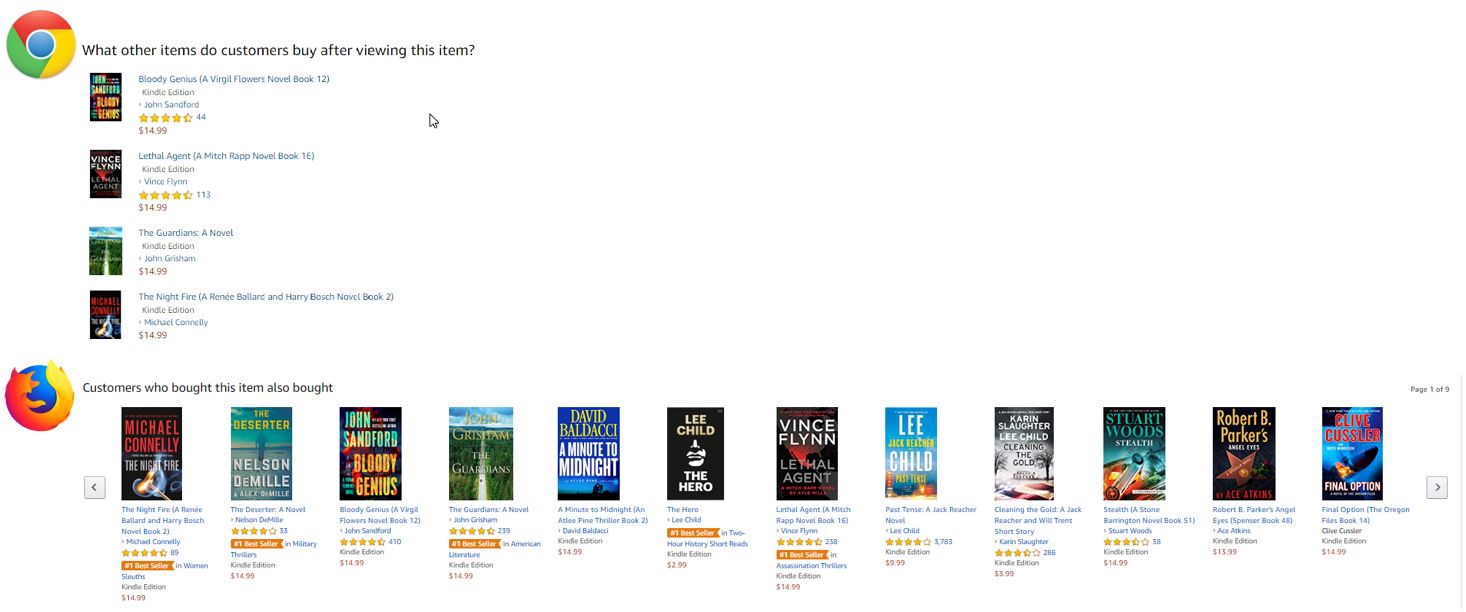
I find this incredibly disheartening on the part of Amazon, as Also Boughts aren’t just one of the most valuable ways authors can promote their books, but they’re also one of the most valuable tools customers can use to find new titles and authors to choose from. By reducing the size of them, or replacing them with ribbons of Sponsored Content, Amazon is cannibalizing both its author base and its customers; breaking the link between buyer and author that has been the mainstay of the company since it first launched the Amazon Kindle.
Of course, Amazon is driven by data – so hopefully they’ll see over time that this isn’t a wise course of action – but until they make that decision, be aware that Free Book Promotions may not always be as effective as they once were – and their future effectiveness could go either way.
Hopefully you found this three-part series valuable, and now have a better grasp of how you can promote yourself as an author and where your advertising budget is best spent. Let us know in the comment section below if you have any thoughts of your own on the subject, or even if you just want to share your experiences with our community of authors!


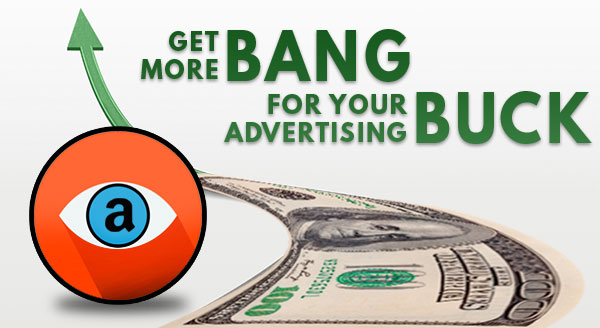


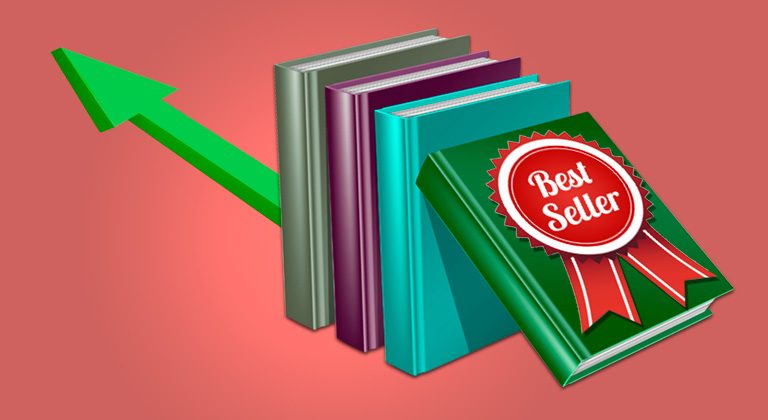
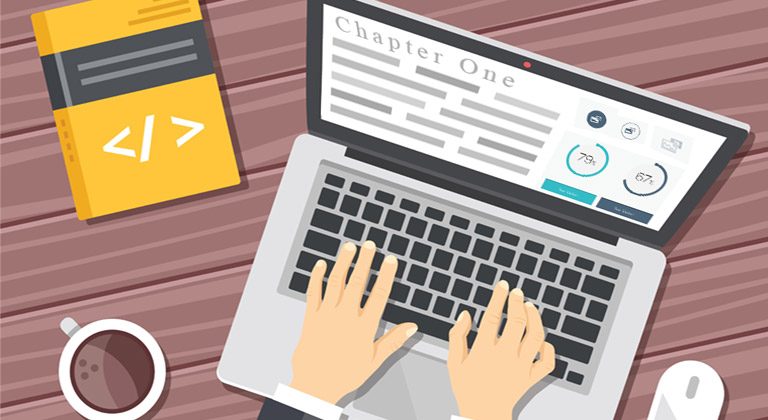

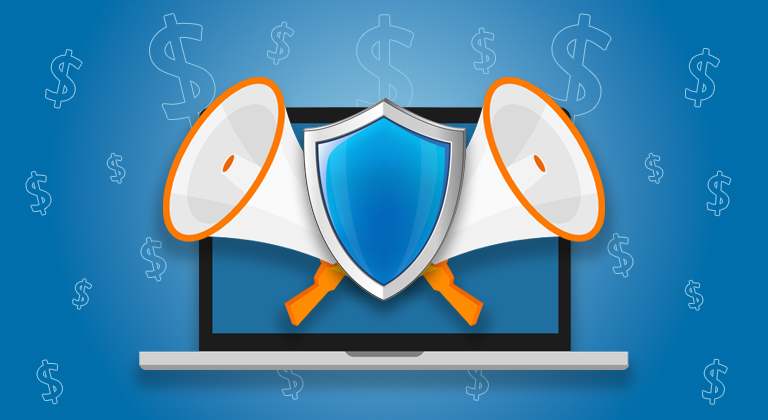


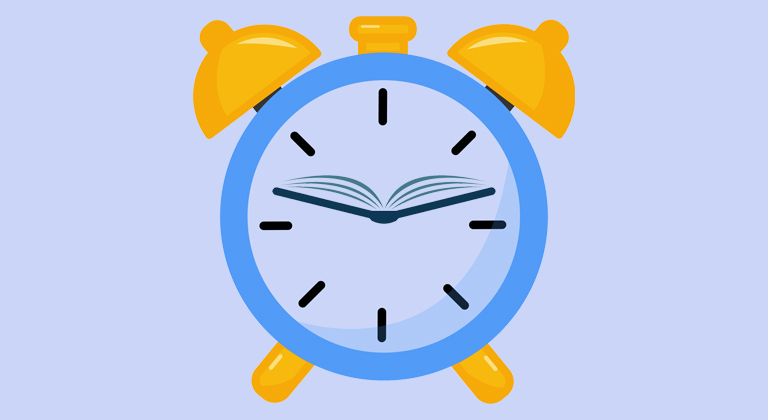
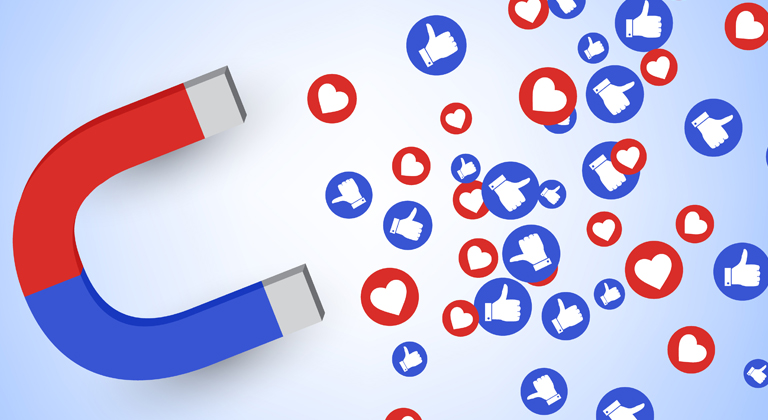
Your interesting suggestions are all targeted at people who publish their own works independently. I (and many other authors) use a publisher, who leaves all the promotion to the author. This means I can’t access Amazon as a publishing client. Can you give us some recommendations for promotion?